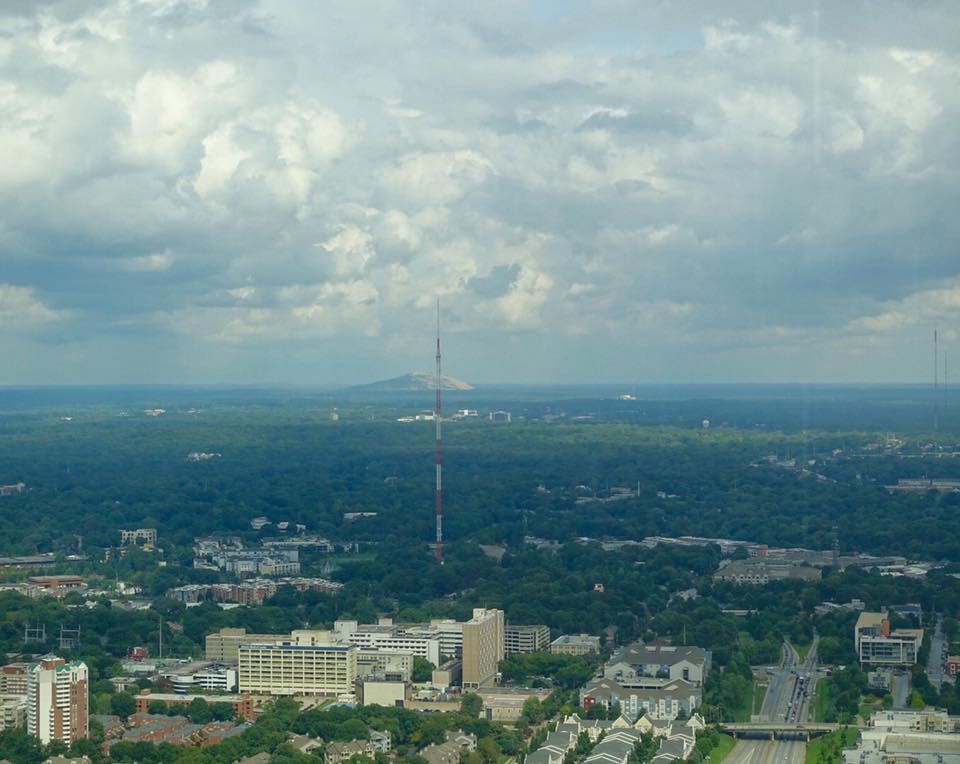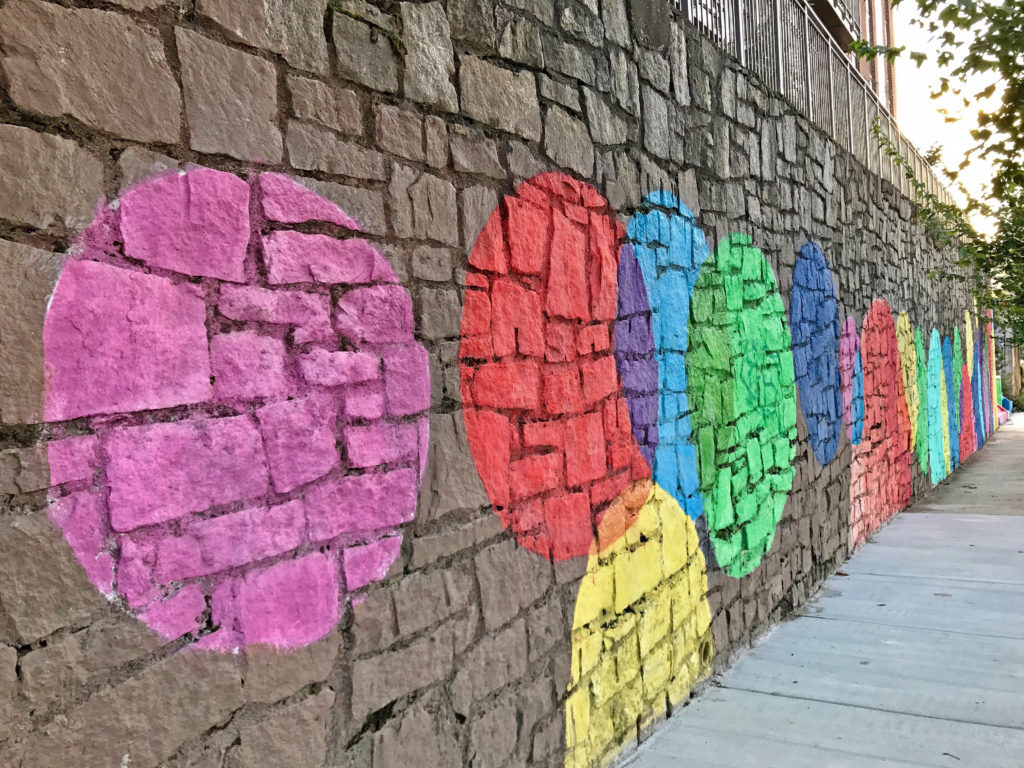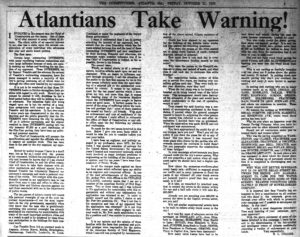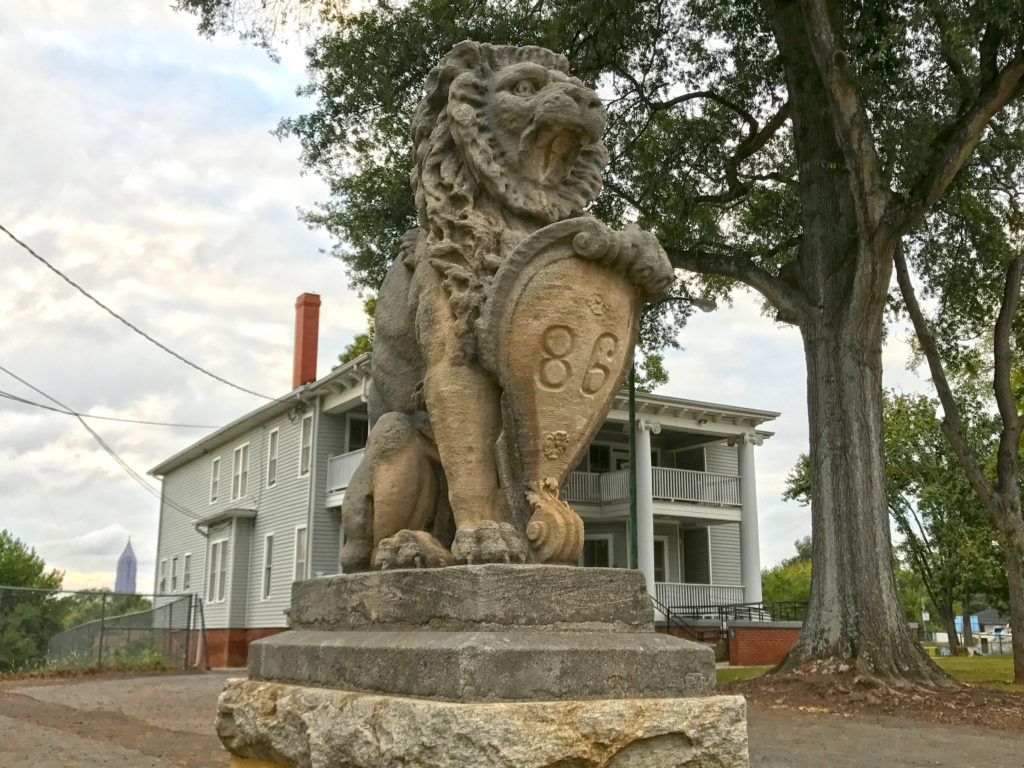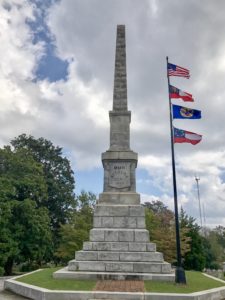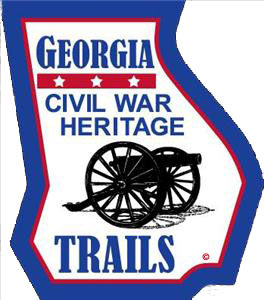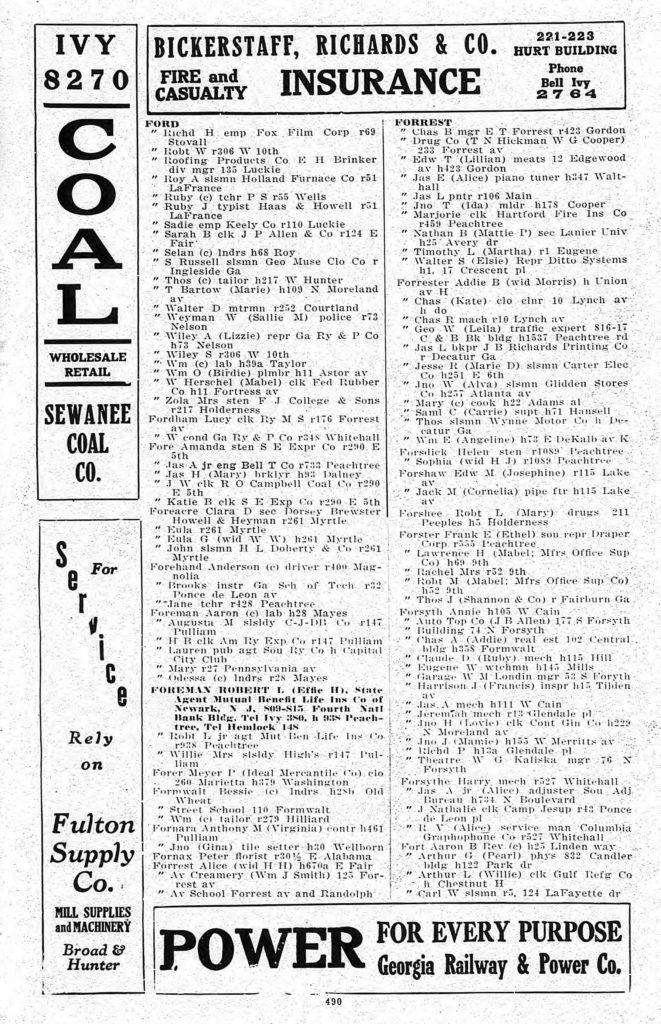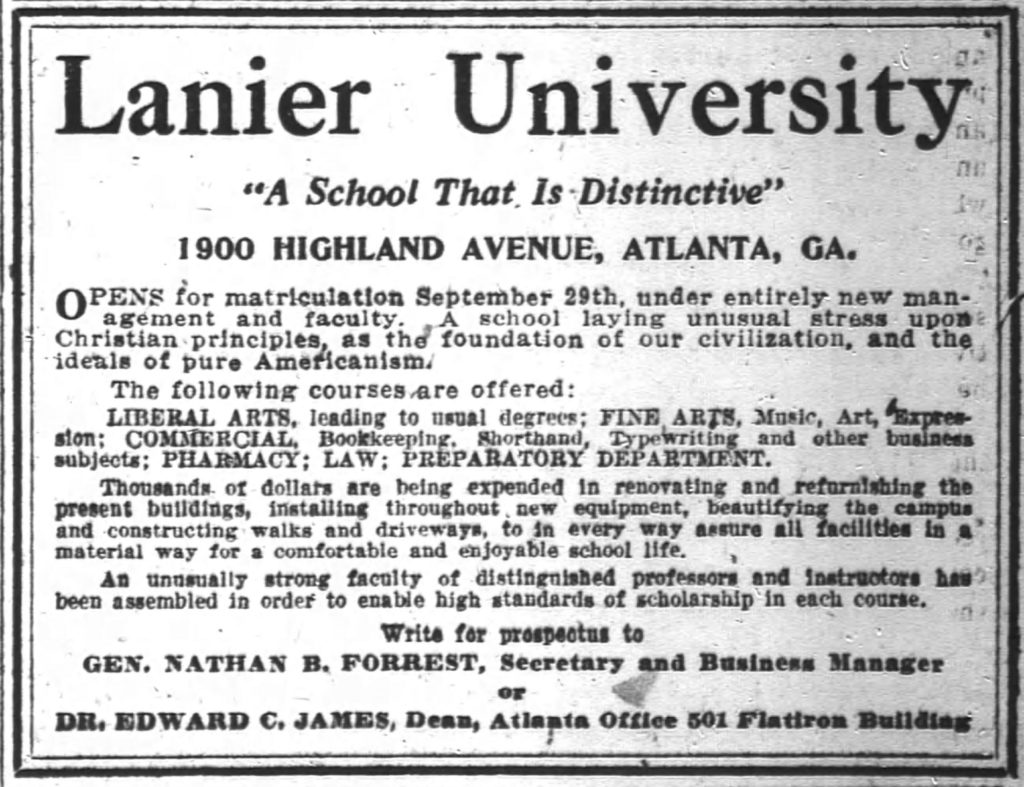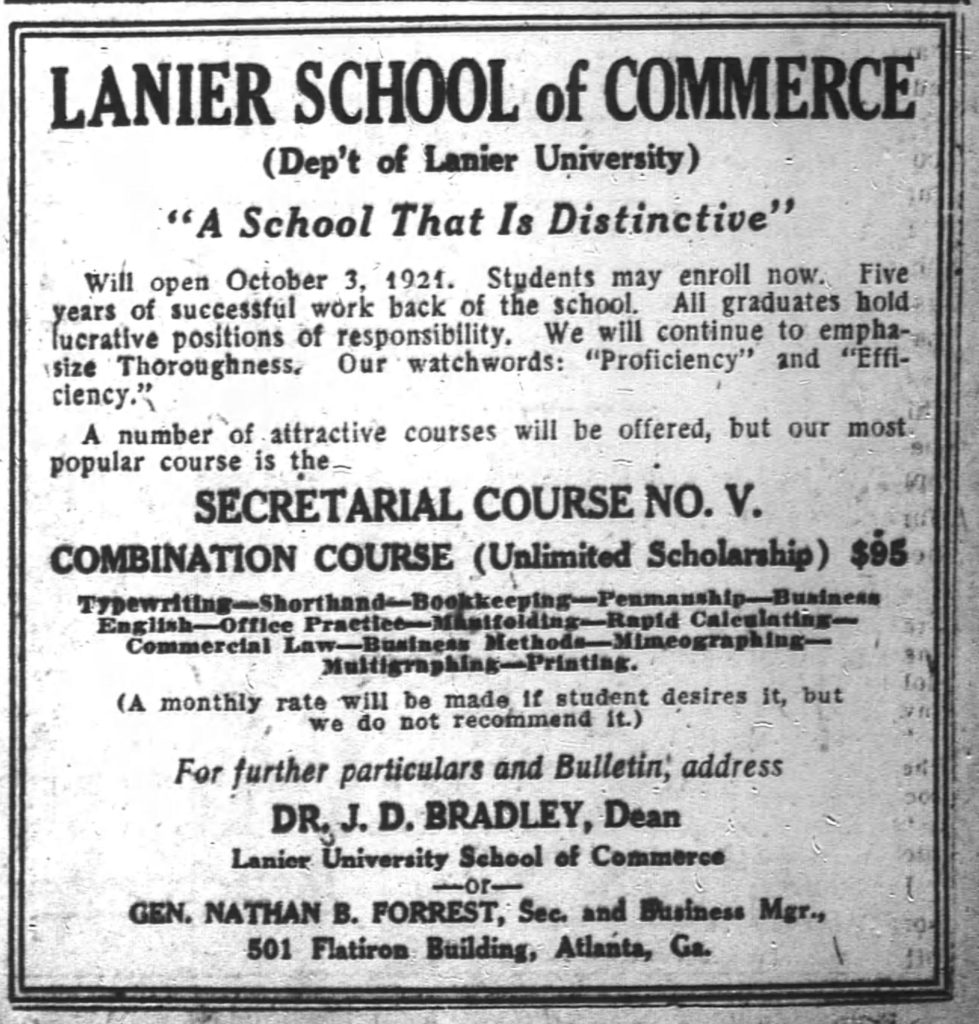“The day will come when the people will come from across the ocean to see the wonders of Dekalb County in her granite mountains.”(1) —Sarge Plunkett, Atlanta Constitution, Feb. 13, 1898
“What used to be here?” is an ever relevant question when one lives in a city like Atlanta that’s regularly dilating and contracting between development and preservation — a city where big urban renewal projects such as MARTA, the 1996 Olympics, and more recently the construction of Mercedes Benz Stadium, and the ongoing multi-million dollar Atlanta BeltLine project have been pitched regularly every generation for the last century, repeatedly shaking up not only the architectural and natural landscapes of Metro Atlanta but also forever shifting the socio-politico-economic structure of the area. There used to be a rather poetic “answer” to the question “what used to be here?” on a sign in someone’s front yard in East Atlanta on Moreland Avenue that read “This Used To Be A Forest.” While Atlanta has often been dubbed a “city in a forest.” I often find myself instead saying “This Used To Be A Mountain” whenever I see copious amounts of Stone Mountain’s signature granite while driving throughout Atlanta’s major streets and neighborhoods.
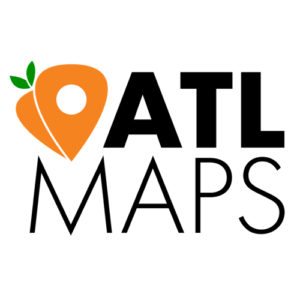 While working on I Am The Mountain over the past few years I’ve often wondered what all of the granite all over the city and surrounding towns means, so I am grateful to collaborate with Atlanta Studies and ATL Maps and its contributors to ambitiously endeavor to map and try to understand the many possible meanings and implications of the undeniable pattern of granite running through Metro Atlanta. If Atlanta were a poem, then ATL Maps offers a way to explicate Atlanta’s infinite layers. This particular layer reminds me of when I would turn over big stones in my yard as a child and discover and study the roly-polies and earthworms living beneath them. Each building or structure pinned to this ATL Map layer, or neighborhood with a high concentration of the trademark granite, can figuratively be lifted up to reveal unexpected living history which may help explain why this stone was intentionally used so widely throughout the city's infrastructure (so much so that practically every curb could well be mapped if the scope of this map were not limited to significant structures and neighborhoods, many of which have grand entrances or "gates" made of the granite. Even Atlanta's Zero Mile Marker. [Edited to add: the Zero Mile Marker moved to the Atlanta History Center in late 2018, which classifies the marker as marble and not granite; 11/06/18 ]
While working on I Am The Mountain over the past few years I’ve often wondered what all of the granite all over the city and surrounding towns means, so I am grateful to collaborate with Atlanta Studies and ATL Maps and its contributors to ambitiously endeavor to map and try to understand the many possible meanings and implications of the undeniable pattern of granite running through Metro Atlanta. If Atlanta were a poem, then ATL Maps offers a way to explicate Atlanta’s infinite layers. This particular layer reminds me of when I would turn over big stones in my yard as a child and discover and study the roly-polies and earthworms living beneath them. Each building or structure pinned to this ATL Map layer, or neighborhood with a high concentration of the trademark granite, can figuratively be lifted up to reveal unexpected living history which may help explain why this stone was intentionally used so widely throughout the city's infrastructure (so much so that practically every curb could well be mapped if the scope of this map were not limited to significant structures and neighborhoods, many of which have grand entrances or "gates" made of the granite. Even Atlanta's Zero Mile Marker. [Edited to add: the Zero Mile Marker moved to the Atlanta History Center in late 2018, which classifies the marker as marble and not granite; 11/06/18 ]
St. Augustine Place gateway in Atkins Park
Mapping the abundant locations featuring granite quarried from Stone Mountain has enormous potential to shed light on a multitude of things about Atlanta’s past, present, and future as we continually examine just who decides what buildings get erected and torn down, what’s worth marking as historic, and what gets preserved and repurposed whenever the city experiences another round of urban renewal "musical chairs.” Which might even lead us to ask: why is it that some buildings and entire town districts featuring the granite are listed in the historic register, while other structures and locations featuring the same stone are not accorded the same historic status or respect? Some of the granite walls lining streets like Moreland Avenue are crumbling in places, while others in East Lake were bulldozed altogether by developers, and some of the big granite walls along North Avenue have been tagged with graffiti or painted over with murals, some of them through Living Walls or the Atlanta BeltLine.
View of Stone Mountain from the storied Westin Peachtree Plaza Hotel
Moving Mountains Along the Railroad
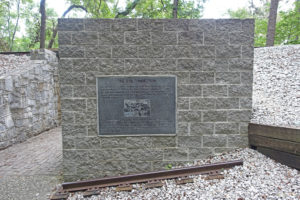
Display at Stone Mountain Park's small quarry exhibit describing the railway's role in moving granite from the mountain all over the country.
Early on, it almost seemed plausible that, if mapped, the granite structures and site walls might well follow the very railway tracks which form the proposed “emerald necklace” of the Atlanta BeltLine, since after all, the granite was transported along various rail lines connecting the quarries with Atlanta via the Georgia Railroad and the Atlanta, Stone Mountain, and Lithonia Railway (as well as various new railways frequently being chartered at this time, such as the Stone Mountain Granite Railway, the Georgia Granite Railroad, the Atlanta Belt Railway Company) — not always without incident or on time due to a number of factors, among them, but not limited to, striking stone-cutters, railcar shortages, and fluctuating freight costs. (2) As I began plotting the locations and doing further research, though, I quickly gleaned that the number of sites made of the granite far exceeds the boundaries of the proposed BeltLine. That said, Stone Mountain granite is indeed prevalent along many sections of the Atlanta BeltLine, particularly at points, though not exclusively, where the Georgia Railroad once crossed at bridges solidly buttressed by the granite, such as at North Avenue and Ralph McGill Blvd. (formerly Forrest Avenue) (3)(26) along the Eastside Trail.
Stone Mountain Granite: A Confederate Brand?
I’m constantly learning that the prevalence of the stone throughout the city isn’t just because it was once in such plentiful supply in the area. And its presence all over doesn't just boil down to a romantic explanation of how a mountain served as a host for Atlanta, the way legends tell of cities like ancient Mesopotamia developing around rivers full of resources to support a civilization. Stone Mountain was once a free natural formation and home to Native Americans(5) The July 1887 sale of Stone Mountain (6)to the Venable Brothers — for $40,000 and the trade of Big Ledge, another quarry site at Arabia Mountain in Lithonia (now a National Heritage Area), to the Davidson Granite Company is a good place to begin a preliminary analysis of where and why the granite from Stone Mountain ended up where it did. But the mountain’s history of human activity (versus its geologic history) (7) easily dates back to 500 A.D. when Native Americans placed a stone wall on top of the mountain that was later removed by early settlers. Unfortunately, often white settlers mythologized their usurpation of Indian land and their occupation of Stone Mountain was no different. Closer examination of this ATL Map layer, especially as it continues to get filled in over time, could at some point elucidate the interpersonal and business dealings among many of the local granite barons, real estate developers, contractors, city planners, politicians, and "pioneer citizens"(8) and "founding fathers" of Atlanta at the time of the granite industry's peak. It will likely also show that many were former Confederate soldiers or Lost Cause sympathizers that certainly comprised a well-off fraternity that stood to profit the most from the success of the granite and real estate industries, while the back-breaking labor fell to countless, nameless granite workers, stone cutters, and convict labor—and before that the enslaved laborers—who built so much of the city, particularly its streets of brick and granite, during the Reconstruction Era and throughout the Jim Crow years leading up to the Civil Rights Movement (the legacy of such similar labor is still being reconciled as Groundwork Atlanta and Lincoln Terminal currently plan to redevelop the land of the infamous Chattahoochee Brick Co. site).(9)
All that remains of Willis F. Denny's estate on Moreland Avenue near The Wrecking Bar (also designed with Stone Mountain granite by Denny as the home of Victor Hugo Kriegshaber) are two lions at the driveway. 86 is the house number based on an older street numbering system. His father-in-law Major Asbury Fletcher Moreland lived near his daughter Gertrude and Willis Denny on the same road, known as County Line Road then, in an estate called Moreland Park (a community later absorbed by Inman Park).
Prominent Atlanta architect and haberdasher Willis F. Denny, (10) who would die young at the age of 32, utilized Stone Mountain granite quite frequently in his projects, and perhaps his relationships with his father-in-law Major Asbury Fletcher Moreland and other "pioneer" Atlanta businessmen influenced his choice of stone. Some of his work includes the Piedmont Hotel (where the Equitable Building now stands), Rhodes Hall, St. Mark United Methodist, Atlanta First United Methodist Church, H.M. Patterson's "undertaker parlors," the duBignon residence on Peachtree St., and the Victor Hugo Kriegshaber residence (now The Wrecking Bar). If Ackerman & Ross had not been awarded the Carnegie Library Commission in 1899 (Denny did submit plans and earn top honors), it could've ended up built of Stone Mountain granite, too, instead of the marble which has suffered a mysterious and inglorious fate.

A 1922 ad for a home on Moreland Avenue boasted “having a granite wall” in front. Such walls are ubiquitous along Moreland Avenue, though many disappear when new development occurs.
Pressure was high around the turn of the 20th Century to use “Georgia stone” and Georgia resources and materials ("shop local" is hardly a new concept), and one way that granite outfits like the Stone Mountain Granite Company pushed their durable stone back then (when the Venables were not often outright strategically donating their granite for free to secure contracts, such as when they offered to provide the granite for Atlanta's Masonic Temple) was to boast that it was “fireproof,” a selling point in a city mythologically reborn as a phoenix from the embers of Sherman’s 1864 inferno and that continued experiencing a motherlode of structure fires before and after Atlanta's Great Fire of 1917. It was also a time of great urgency in proving the superiority of Georgia's granite against other stones nationwide (possibly to the point of overcompensating by using it everywhere?), so as to secure as many city and federal government contracts as possible. Around 1895, Georgia granite had been deemed to have inferior resistance strength by the District of Columbia and was therefore cut out of bidding for such government projects until the ban was lifted in 1916 — because the granite had proven itself. (11)
So many structures, retention walls, monuments, (12)curbs, and sewers made of Stone Mountain granite can be found across city limits and county lines in Metro Atlanta that they appear along the cityscape like ancient ruins in the foreground of the modern high-rise lofts continually being built or sometimes flank the roads like the imposing walls of a military fort. Moreover, many of the notable institutions throughout the city, such as universities, post offices, churches, cemeteries, courthouses, and many other government buildings are built of Stone Mountain granite.
The presence of this granite is so familiar that it even presents at times as its own recognizable “brand” to its geologic “DNA parent,” Stone Mountain. A brand of just what, though? Because of the Confederate carving on Stone Mountain and Stone Mountain Park’s enduring Confederate “brand” (opening its gates on the centennial of Lincoln’s assassination as a slap in the face to the Civil Rights Movement), has the granite in Metro Atlanta beyond the mountain proper ever resonated with a type of Confederate brand recognition then? I think it is fair to suggest that it does and that the granite originating from the mountain, especially when the mountain was monopolized by the Venables and the Ku Klux Klan, more than likely contributed to institutionalized racism then and now, however nuanced, through its frequent use in Metro Atlanta’s architecture and infrastructure. As if the rock used in neighborhoods throughout Atlanta (and beyond!) somehow represented a stealthy extension of the white supremacy emanating from the Klan and Confederate stronghold at Stone Mountain.
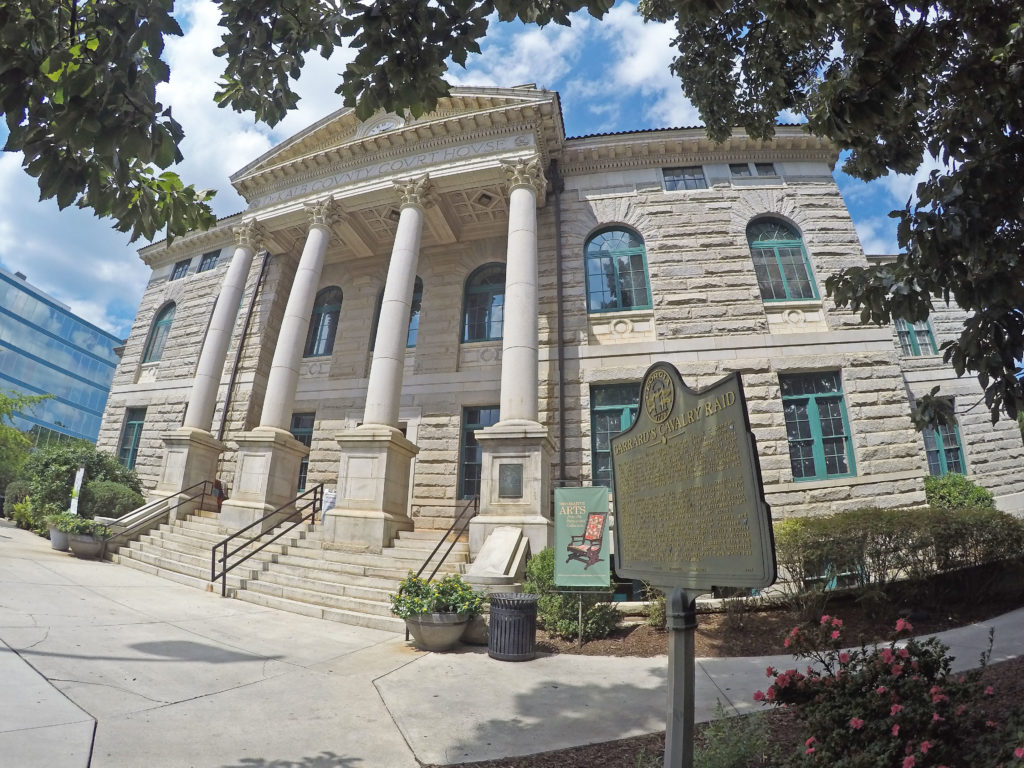
The Dekalb County Courthouse built of Stone Mountain granite is currently in the news for the prominent Confederate monument (made by the Butler Marble and Granite Company of Marietta) just beyond its steps and has also been a filming location for movies recently. A plaque to Baron Dekalb there on the courthouse grounds and a bust of Stephen Decatur in the nearby square are also mounted on the Stone Mountain granite. This is especially fascinating given that Decatur threatened to secede from Dekalb County in 1897 if the courthouse were to be moved to Stone Mountain.
 Though the mountain itself will always be an innocent gift of nature, home today to a variety of plants and animals and a favorite place to hike for quite a cross-section of people, it’s still simply impossible to ignore how, along with the mountain's continued commodification and Disneyfication, (13) it was forever politicized by the Klan’s declaration of their 20th Century rebirth there over Thanksgiving weekend in 1915 and by their continued use of the mountain for gatherings for decades thereafter. The Venables deeding the north face of Stone Mountain to the United Daughters of the Confederacy to turn into the Confederate carving that took over fifty years to complete further debased the mountain. (14) The carving was perfunctorily completed in 1972 and still rises over Atlanta in 2017 as a painful relic of white supremacy. A few years in advance of the 1996 Summer Olympics, 13 Confederate flags on top of the mountain were removed, around the same time the decades-long tradition of Klan rallies in Stone Mountain Village ceased. It has always been my opinion that Stone Mountain Park bears a special responsibility, perhaps even above many other Confederate monuments, to never perpetuate the kind of white supremacy it accommodated and instigated during the Klan’s reign there and during the Civil Rights Movement when the park was created as a direct affront to integration (the same arguments about white culture and Southern heritage being threatened that get trotted out now by white nationalists were used in 1965, too).
Though the mountain itself will always be an innocent gift of nature, home today to a variety of plants and animals and a favorite place to hike for quite a cross-section of people, it’s still simply impossible to ignore how, along with the mountain's continued commodification and Disneyfication, (13) it was forever politicized by the Klan’s declaration of their 20th Century rebirth there over Thanksgiving weekend in 1915 and by their continued use of the mountain for gatherings for decades thereafter. The Venables deeding the north face of Stone Mountain to the United Daughters of the Confederacy to turn into the Confederate carving that took over fifty years to complete further debased the mountain. (14) The carving was perfunctorily completed in 1972 and still rises over Atlanta in 2017 as a painful relic of white supremacy. A few years in advance of the 1996 Summer Olympics, 13 Confederate flags on top of the mountain were removed, around the same time the decades-long tradition of Klan rallies in Stone Mountain Village ceased. It has always been my opinion that Stone Mountain Park bears a special responsibility, perhaps even above many other Confederate monuments, to never perpetuate the kind of white supremacy it accommodated and instigated during the Klan’s reign there and during the Civil Rights Movement when the park was created as a direct affront to integration (the same arguments about white culture and Southern heritage being threatened that get trotted out now by white nationalists were used in 1965, too).
Memorial Drive: A “Granite Highway”
In addition to being the source of the building material for some of Atlanta’s well-known buildings and universities, few may realize that a century ago Stone Mountain stood at the center of an extensive infrastructure project of its day. The natural landmark that is now touted as one of the state’s number one tourist attractions was once grandly envisioned to connect Atlanta and environs along a “Granite Highway.”(15) The “Granite Highway” was referenced in a 1914 letter (16) to the Atlanta Constitution from local attorney and politician William Terrell suggesting a Confederate carving on Stone Mountain that would be connected to Atlanta by a “granite highway.” A May 25, 1914 newspaper article ran the day before which described the vision of the "Granite Highway" and underscored what a major “publicity asset” Stone Mountain was. Helen Plane, (17) of the United Daughters of the Confederacy picked up his idea the Confederate carving in 1915, and a “Granite Highway” began to take shape around the planning of the monument and during a time when big roads projects were getting underway across America, such as the Dixie Highway and The Lincoln Highway, and it was greatly hoped the “Granite Highway” would be completed in time for the first ever American Road Congress (18) held in Atlanta in November 1914.
A small bronze plaque placed on the Dekalb County Courthouse in 1939 by the Camp Fire Girls acknowledged the area's Creek and Cherokee Indian trails which "became the wagon roads of the white man" and "the great highways of the nation." Beyond the Native American Heritage Sites managed by the National Park Service, imagine a country where an abundance of markers to Native Americans exist in every city and aren't eclipsed by Confederate monuments and Civil War history. Imagine an inclusive country where Native Americans' trails are as well-catalogued and marked as those designating Civil War sites.

A granite marker for the Jefferson Davis Highway can still be seen on Ponce de Leon Avenue and East Lake Rd. across the street from St. Elias of Atlanta Antiochian Orthodox Christian Church.
The dominance of the railroads was being challenged by increased attention to building roads and highways and American’s growing interest in automobiles and tourism. While some of these new highway routes offered ways to symbolically unite many previously war-torn U.S. states through auto travel, other highway routes were expressly mapped to link Civil War battlefields (19) or sites "of historic interest" in the eyes of those with the power and means to determine what's important enough to preserve. Part of the National Dixie Highway was encouraged to follow, and therefore preserve and mark, the Old Capitol route (20) from Atlanta to Milledgeville. The never completed Jefferson Davis Memorial Highway, project devised by the United Daughters of the Confederacy in the early 1900s is another good example of how infrastructure was used, however subtly, to institutionalize Confederate ideals and boost "Confederate tourism," and such institutionalization was especially underscored when government institutions jointly funded and participate such projects at the time. A granite marker for the Jefferson Davis Highway can still be seen on Ponce de Leon Avenue and East Lake Rd. across the street from St. Elias of Atlanta Antiochian Orthodox Christian Church (this year another Jefferson Davis Highway monument was tarred and feathered in Arizona). In 1923, federal aid was also granted for a highway (21) to run from Stone Mountain to Washington, D.C. It also wasn't uncommon then to find local road trips charted (22) out in the newspaper, such as this one plotted around Lake Bennett in Fayetteville, GA and taking the driver through Jonesboro, GA. Or this one from 1922 plotting the drive from downtown Atlanta to Stone Mountain.

Just as real estate listings today boast of proximity to the Altanta BeltLine, ads once promoted homes and lots conveniently located along the “Granite Highway" in the early 20th Century.
An early mention of Memorial Drive (23) can be seen was when ground was broken in Avondale Estates in 1927 in a plan to connect it with Stone Mountain and “become part of the federal highway between Athens and Atlanta” which was concurrently underway. It was also proposed then that Memorial Drive should be connected to “an extension of East Fair Street, thus providing an additional highway to the heart of the city.” Fair St. was expanded during the 1930s and 1940s and was ultimately renamed Memorial Drive in 1940-41. 1933, Fifth District Congressional Representative Robert Ramspeck proposed that Memorial Drive run from Stone Mountain to Marietta National Cemetery. Even today both Memorial Drive and Ponce de Leon Ave. still bear green mile marker signs directing motorists from downtown to Stone Mountain (from the Dekalb County zero mile marker at Moreland Avenue (formerly County Line Road), one sees a 14 mile sign and then a 9 mile sign pointing to Stone Mountian). And just as real estate listings today boast of proximity to the Altanta BeltLine, ads in the Atlanta Constitution once promoted homes and lots conveniently located along the “Granite Highway" in the early 20th Century. Such history is currently relevant, as redevelopment of the Fulton County section of the Memorial Drive Corridor and some of the Dekalb County part of the road via the Memorial Drive Overlay are underway.
“I’d Rather Be a Forest Than A Street”
 Another vestige of the Confederacy intersecting with Atlanta's old infrastructure is faintly visible beneath the Eastside Trail of the Atlanta BeltLine at Ralph McGill Boulevard, formerly known as Forrest Ave. until the name was changed in 1980 after an eight-year battle. An old marker dedicating the 1926 underpass, known then as the Forrest Avenue Underpass (26) after the Klan's first Grand Wizard, General Nathan Bedford Forrest, can be seen through the paint (a white furl slightly obscuring his first name). How poetic, a mural called "Union" painted over an underpass once named for a Confederate General (his grandson, Nathan Bedford Forrest, II, (27) would later become the Klan's Grand Dragon and the secretary of the Stone Mountain Memorial Association and head of the short-lived Klan college, Lanier University in Morningside). Even more fascinating is the title of the painting directly across from it, "City in A Forest" (read: not Forrest in a City), especially the image of a devil, if one realizes that General Sherman once referred to Nathan Bedford Forrest as "Devil Forrest."
Another vestige of the Confederacy intersecting with Atlanta's old infrastructure is faintly visible beneath the Eastside Trail of the Atlanta BeltLine at Ralph McGill Boulevard, formerly known as Forrest Ave. until the name was changed in 1980 after an eight-year battle. An old marker dedicating the 1926 underpass, known then as the Forrest Avenue Underpass (26) after the Klan's first Grand Wizard, General Nathan Bedford Forrest, can be seen through the paint (a white furl slightly obscuring his first name). How poetic, a mural called "Union" painted over an underpass once named for a Confederate General (his grandson, Nathan Bedford Forrest, II, (27) would later become the Klan's Grand Dragon and the secretary of the Stone Mountain Memorial Association and head of the short-lived Klan college, Lanier University in Morningside). Even more fascinating is the title of the painting directly across from it, "City in A Forest" (read: not Forrest in a City), especially the image of a devil, if one realizes that General Sherman once referred to Nathan Bedford Forrest as "Devil Forrest."

Forrest Rd. in Pine Lake does not reflect the current diverse and progressive community (no, it is not a misspelling of "forest").
There was once actually a tablet to Nathan Bedford Forrest placed at Forrest Avenue and Peachtree Street in 1903 not far from today's Atlanta Civic Center (at the time it would've been near Buttermilk Bottom), paid for by real estate developer Forrest Adair, who was named after General Nathan Bedford Forrest, as his father, George Washington Adair, had been General Forrest's aide-de-camp during the Civil War. There was once a Nathan Bedford Forrest Elementary School at 608 Forrest Avenue in the Old Fourth Ward, which later, while still named the Nathan B. Forrest School, became an arts consortium in the 1970s and is now the site of lofts under construction near the Aramark Uniform Services on Glen Iris Drive, within walking distance of the Historic Fourth Ward Park splash pad along the BeltLine. Surprisingly, today there are still several streets in Metro Atlanta named after Nathan Bedford Forrest (one in Stone Mountain and one in Pine Lake come to mind). Caroline Klibanoff's map of Confederate street names is also a useful resource illustrating how the South may have lost the Civil War but they would assert themselves and mark their territory through infrastructure. Despite what many may think, Atlanta has a long history of changing street names, and the reasons sometimes involved segregation of streets around the Georgia Railroad.(28)
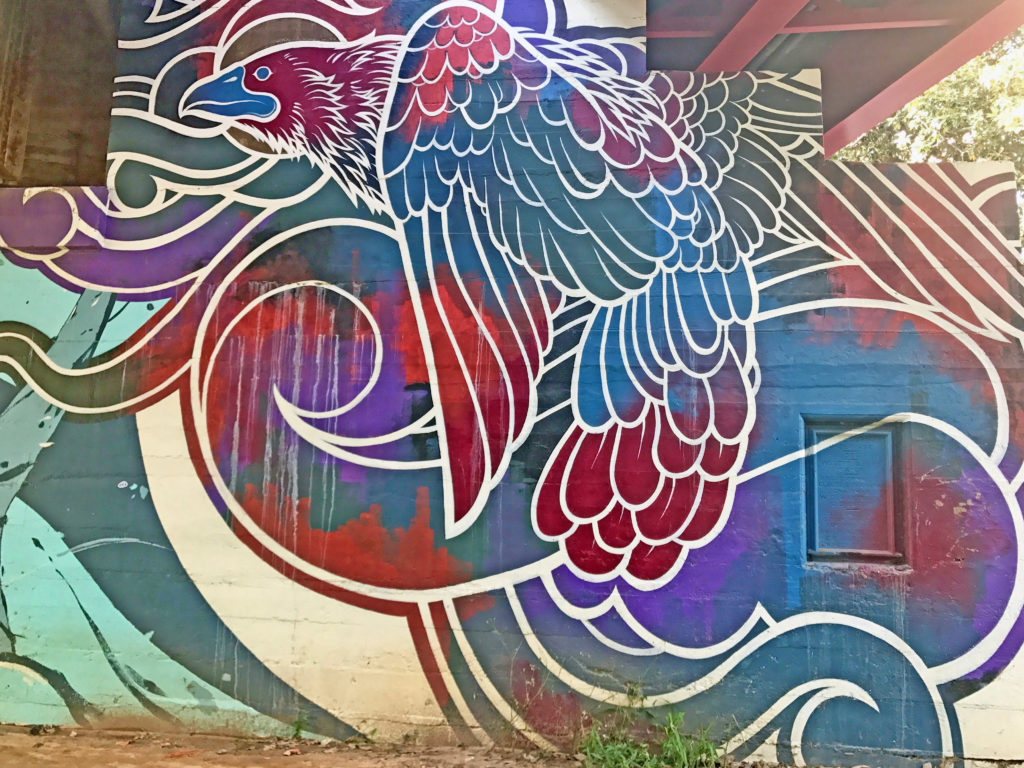
"Union" mural painted over old Forrest Avenue Underpass beneath the Eastside Trail of the Atlanta BeltLine at Ralph McGill Blvd.
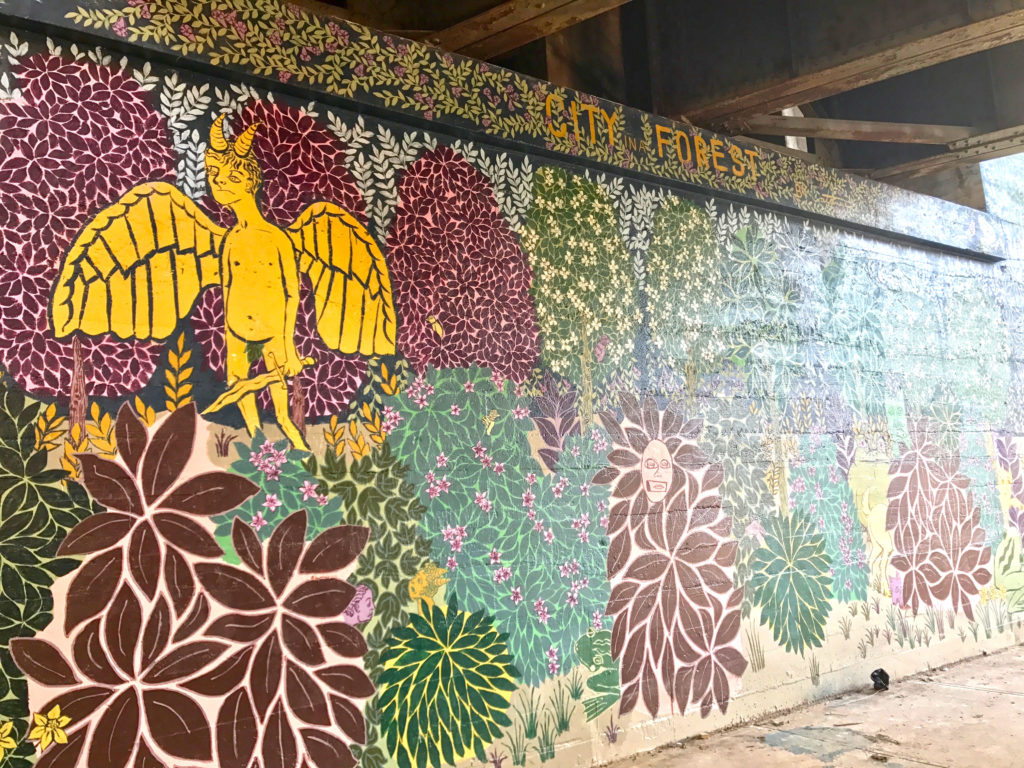
"City in a Forest" mural painted over old Forrest Avenue Underpass beneath the Eastside Trail of the Atlanta BeltLine at Ralph McGill Blvd.
Strange thinking Nathan Bedford Forrest, II, once had an office where he conducted Klan business and Lanier University (see above ) business on the 8th Floor of the Flatiron Building in Atlanta's Fairlie-Poplar Historic District downtown (known once as the English-American Building) [update 2-05-18: Atlanta held the 2018 New Year's "Peach Drop" from this building]. He was the secretary of the Stone Mountain Memorial Association when, in 1923, he received a telegram from former President William Howard Taft, who was then serving as the Chief Justice of the Supreme Court. Such was the great federal support of the imminent Confederate carving on Stone Mountain at the time (and the abundance of reverential newspaper stories), particularly during the Klan's height in the 1920s with Atlanta at its center, federal support which continued from President Harding's day well on up to when Vice President Spiro Agnew attended the official carving dedication ceremony 47 years ago in 1970 (the carving would actually be completed in 1972). No wonder so much granite from Stone Mountain ended up all over Atlanta and the nation!
Conclusion
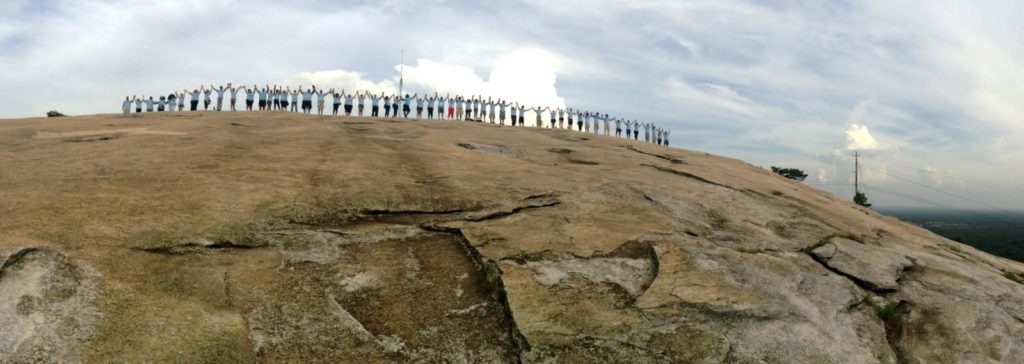 I grew up five minutes away from Stone Mountain Park in a middle-class neighborhood along the railroad tracks on E. Ponce de Leon Avenue during a time when Klan rallies still took place(24)in a field beside the mountain well into the 1990s (the street in Shermantown is still named Venable Street, and former Imperial Wizard James Venable(25) died my senior year in high school in 1993). Americans have been increasingly confronting and coming to terms with the true white supremacist meaning of Confederate monuments, flags, and symbols which often serve as beacons of racist violence, and many of these outmoded monuments and statues are rightfully being removed from their pedestals in America's town squares and being relocated to more appropriate spaces such as cemeteries and museums.
I grew up five minutes away from Stone Mountain Park in a middle-class neighborhood along the railroad tracks on E. Ponce de Leon Avenue during a time when Klan rallies still took place(24)in a field beside the mountain well into the 1990s (the street in Shermantown is still named Venable Street, and former Imperial Wizard James Venable(25) died my senior year in high school in 1993). Americans have been increasingly confronting and coming to terms with the true white supremacist meaning of Confederate monuments, flags, and symbols which often serve as beacons of racist violence, and many of these outmoded monuments and statues are rightfully being removed from their pedestals in America's town squares and being relocated to more appropriate spaces such as cemeteries and museums.
As this map layer is already beginning to illustrate, Stone Mountain granite literally helped to build Atlanta. Since a great deal of Atlanta is structurally linked with Stone Mountain, Atlanta is arguably implicated, however symbolically, in whatever has gone on there, what goes on there right now, and should care more than ever what will happen there next. Georgia was the last state to rejoin the union on July 15, 1870, so its identity is also undeniably a very "Confederate" one. The narratives and urban designs of so many Southern cities such as Atlanta have been too long dominated by and organized around Civil War history, largely at the exclusion of so many other people's experiences and other important historic events. Context and inclusion are more important than ever today, and if we are truly to teach history responsibly, we must evolve in order to improve as a society and to remedy the wrongdoings of past generations so that we can proceed humanely and ethically with Atlanta's growth, in caring for our environment, and fostering the well-being of everyone in Atlanta's communities. How a city uses land and natural resources and labor to build and conceive of its infrastructure, house its citizens and workers, and to create and maintain shared public spaces in between, will always be of great importance.
This Used To Be A Mountain
This basin left behind when the cutting of stone ceased at one of the quarries sometimes fills with days of rainfall into a pond glistening against the mountain it once was a part of. Several quarry ponds of various sizes exist at Stone Mountain after great amounts of rain.
Footnotes
- Sarge Plunkett, “Wonder of World in Granite,” Atlanta Constitution, Feb. 13, 1898.
- "Our Neighbors, The Allies of Atlanta in Her Onward March, Sketches of Towns Tributary to the Gate City, and Last Year's Business of Each; Atlanta Constitution; Sept. 11, 1875; “Chipped Stone 150 Cars Strong Tendered Free,” Atlanta Constitution; May 27, 1899, “Notice” (Atlanta Belt Railway Company charter applied for), Atlanta Constitution, Sept. 8, 1899; “The Jubilant Asphalt Trust As It Strikes The People of Atlanta: A Statement of Facts as Presented by W.H. Venable, Explains Why He No Longer Fights To Secure the Contract on Capitol Avenue—Why He Requested Chance to Compete Again,” Atlanta Constitution; Apr. 1, 1901; “Will Build Road To Quarry: Capitalists To Build from Rock Chapel Mountain to Lithonia, Dekalb County,” (new railway), Atlanta Constitution; Feb. 14, 1904, “Railroad Must Move Granite: Commissioner Stevens Investigates Conditions at Lithonia,” Atlanta Constitution; Apr. 13, 1907, “Granite Men Get Demurrage: Commission Approves the Claims on Account of Tie-up at Lithonia,” Atlanta Constitution; May 4, 1907, “Paving Concerns Seek Injunction: Road Material Companies File Petition Claiming Violation of Charter by Georgia Railway and Power Co.,” Atlanta Constitution; Jun. 30, 1916,“Georgia Granite Railroad To Be Sold At Auction in Decatur in December,” Atlanta Constitution; Nov. 19, 1917,“Sewage System Delays Will Be Rigidly Probed,” Atlanta Constitution; Feb. 12, 1913, “Belt Line Contract Is Let,” Atlanta Constitution; Oct. 21, 1899.
- "City Street Renamed Ralph McGill Boulevard," Atlanta Constitution; Nov. 10, 1980.
- “Mysterious Rock Wall Once Circled Stone Mountain,” Atlanta Constitution; Nov. 1, 1979
- “Faith in Atlanta Land Has Made a Fortune," "Granite Is State’s Wealth Producer,” Atlanta Constitution; May 12,1914
- “There Has Been A Change: Southern Granite Company Changes Hands—Stone Mountain Still Stands,” Atlanta Constitution; July 18, 1887. “Venable’s Big Rally: At the Courthouse Last Night A Big Crowd,” Atlanta Constitution; Oct. 1, 1890 (“I secured the Technological School for Atlanta.").“Big Granite Deal: The Venable Brothers Secure A Monopoly of the Stone Mountain Quarries,” Atlanta Constitution, Mar. 14, 1894
- “How Stone Mountain Was Created,” Atlanta Constitution, Apr. 21,1929; “The Mineral Resources of Certain Southern States,” Atlanta Constitution; Nov. 7, 1897..
- “Pioneer Citizens’ History of Atlanta 1833-1902,” by Pioneer Citizens Society of Atlanta; “Adairs Will Celebrate Fiftieth Anniversary Of Pioneer Real Estate Agency of the World: Why the Names ‘Adair’ and ‘Atlanta’ Are Inseparable,”Atlanta Constitution; Mar. 21, 1915. “Faith in Atlanta Land Has Made a Fortune," (Ansley) Atlanta Constitution; May 12,1914.
- Richard Becherer,"Bricks and Bones: Discovering Atlanta's Forgotten Spaces of Neo-Slavery," Southern Polytechnic State University; pg.436-444; "Pave-Cutters Strike,” (Scotch stone-cutters at Stone Mountain), Atlanta Constitution; Aug. 16, 1883
- “Willis F. Denny Is Dead. Well Known Atlanta Architect Expired at Denver, Colorado, Yesterday Morning,” Atlanta Constitution; Aug. 19, 1905.“Administrator’s Sale,” Atlanta Constitution; May 7, 1907.“Carnegie Library Commission Awarded To Ackerman & Ross,” Atlanta Constitution; Dec. 23, 1899.“Two Prize Winning Designs For Carnegie Library Building Submitted By Local Architects,” Atlanta Constitution; Dec. 27, 1899.“H.M. Patterson, Funeral Director, Has Won Well Deserved Success,” Atlanta Constitution; Aug. 7, 1903.“New Church For Inman Park: Methodists Will Erect a Handsome Structure on Edgewood Avenue,” Atlanta Constitution; Jul. 10, 1896
- “A Very Plain Answer,” Atlanta Constitution, November, 25, 1883. “Stone Mountain Granite: Beautiful Specimen of The Georgia Granite Taken From 25 Feet Below the Surface,” Atlanta Constitution; Nov. 22, 1883. “Ten Stories High,” Atlanta Constitution; Feb. 26, 1896.“Fighting Georgia Granite,” Atlanta Constitution; Jan. 26, 1895 (re: Kansas City contracts), “A Final Rejection: Georgia Granite Has Been Shut Out By the Government, No Power to Investigate The Matter,” Atlanta Constitution; Feb. 20, 1895,“Granite Abroad,” Atlanta Constitution; Jul. 10, 1886 (re: Cincinnati contracts), “Mr. Sam Venable and the Atlanta Granite Company—The Business They Are Doing And Propose to Do,” Atlanta Constitution; Jan. 1, 1888, “Georgia’s Progress: Industries Developed Within the Last Few Years, Granite For Street Paving,” Atlanta Constitution, Jan. 1, 1888. “The Masonic Temple: Generous Offer of Hon. W. H. Venabale, Stone Mountain Granite Free of Cost, Except the Mere Expense of Quarrying if the Building is a First Class One,” Atlanta Constitution; Aug. 1, 1890. “Chipped Stone 150 Cars Strong Tendered Free,” Atlanta Constitution; May 27, 1899, “Granite Will Be The Stone Used,” Atlanta Constitution; Dec. 31, 1899. “About Granite: A New Firm That Is Pushing Its Business Into New Territories,” Atlanta Constitution; May 17, 1896 (Venable & Collins Granite Co.).“Masons Will Open Magnificent New Temple,” Atlanta Constitution; Feb. 21,1909."For Georgia Granite Howard Makes Fight: Congressman Alleges Stone Mountain Company Is Victim of Discrimination," Atlanta Constitution; July 31, 1913. "Dr. Gaertner Raises $3,433 For Oglethorpe, Stone Valued at Approximately $2,000 Has Also Been Offered College," Atlanta Constitution; Apr. 11, 1914; "Big Government Order For Georgia Granite: $85,000 Worth of Stone Mountain Rock Will Be Used For Marine Barracks," Atlanta Constitution; May 4, 1916. “Millions of Tons Of Finest Granite Lie Close to Atlanta,” Atlanta Constitution; Sept. 26, 1917.“Real Estate Ad: ‘Here’s A Good Price Reduction,’” Atlanta Constitution; Jan. 28, 1922.
- “Shaft At Oakland To Be 61 Years Old On Memorial Day,” Atlanta Constitution; Apr. 25, 1935.“Oakland Cemetery, ‘Our Confederate Dead. 1873. The Sexton’,”Atlanta Constitution; Dec. 14, 1873.“First Confederate Cemetery,” Atlanta Constitution; Jan. 25, 1891 (Resaca, STM granite).“Wirz Monument,” Atlanta Constitution; May 9, 1909 (Andersonville, STM granite).“Decatur Dedicates Memorial Today,” Atlanta Constitution; Jan. 21, 1938 (Decatur, Stephen Decatur STM granite).“Stone Mountain Granite Marks Crockett Home,” Atlanta Constitution; Jul. 14, 1927.“Dekalb County’s New Courthouse Dedicated At Decatur Yesterday,” Atlanta Constitution; Feb. 27, 1900.“Miss Rebecca Candler To Unveil Monument,” Atlanta Constitution; Apr. 23, 1908 (Confederate courthouse monument). “Breaking Ground For Granite Marker,” Atlanta Constitution, Jan. 31, 1926 (old Girls High School/now Roosevelt Apts.)“Camp Fire Girls To Unveil Marker,” Atlanta Constitution; Sept. 20, 1939 (Indian trails).
- Tim Moore, “The Disneyfication of Stone Mountain: A Park’s Response To Its Visitors,” Honors Thesis, American University, 2010, http://auislandora.wrlc.org/islandora/object/0910capstones%3A88/datastream/PDF/view.
- “Fifty Year Quit Claim Deed To Stone Mountain Is Owned By Association, Letter Says,” Atlanta Constitution; Aug. 15, 1927.
- “Big Boost is Given to Granite Highway by Property Owners,” Atlanta Constitution, February 26, 1914: 3; “DeKalb to Subscribe Over Half of Cost of Granite Highway,” Atlanta Constitution, March 4, 1917: 7; “Mercer Named Engineer of Granite Highway,” Atlanta Constitution, March 11, 1914: 5; “Plans Are Laid for Granite Road in DeKalb County,” Atlanta Constitution, April 4, 1914: 9; “Report of Engineer On Granite Highway,” Atlanta Constitution, April 7, 1914: 12; “The Granite Highway,” Atlanta Constitution, May 25, 1914; “Advertisement: Dixie Highlands,” The Atlanta Constitution, May 3, 1914.
- “Stone Mountain, Eternal Temple to Confederacy, Is Terrell’s Suggestion,“ Atlanta Constitution, May 25, 1914. “WIlliam H. Terrell Announces Candidacy For Court of Appeals,” Atlanta Constitution; May 7, 1914.
- “Mrs. Plane Leading Movement For Monument to Confederacy Which Will Be World Wonder,” Atlanta Constitution; Sept. 26, 1915. "Georgia May Justly Claim the Eighth Wonder of the World When Artist Borglum Completes Stone Mountain Memorial," Atlanta Constitution; Jan. 28, 1917.
- "Boulevard Drive —Kirkwood's Newest Improvement," Atlanta Constitution; May 31, 1914; “Makers of Good Roads,” Atlanta Constitution; Nov. 2, 1914.
- “The Siege of Atlanta—and Afterwards,” Atlanta Constitution; Oct. 5, 1919; "Battle of Atlanta Tablets Will Be Unveiled Friday; Atlanta Constitution; Oct. 10, 1919; “Two Battlefields to Be Linked By Great Memorial Parkway,” Atlanta Constitution; Nov. 18, 1933; “Dekalb Plans 82-Acre War Memorial Park: Memorial Drive Area is Where Battle of Atlanta Started,” Atlanta Constitution; Jun. 5, 1941.
- “Dixie Directors Will Be Urged To Adopt the Old Capitol Route From Atlanta to Milledgeville,” Atlanta Constitution; May 11, 1916.
- “Highway Pledged By Government,” Atlanta Constitution; Oct. 28, 1923, pg. 9
- “50-Mile Drive by Beautiful Lake Bennett Fine All-Day or Afternoon Pleasure Trip,”; Atlanta Constitution; May 3, 1921; “Log of Road to Stone Mountain, The Largest Rock Mound In the World, Is Given for Benefit of Visiting Motorists, Stone Mountain Is Wonder of Entire South,” Atlanta Constitution; Aug. 6, 1922.
- “Ceremonies Mark Ground Breaking on Avondale-Stone Mountain Highway,” Atlanta Constitution; Oct. 19, 1927; “Wider Fair Will Cut Memorial Distance: Work Will Get Under Way, Dekalb Commissioner Reports,” Atlanta Constitution, Aug. 2, 1930; “Ramspeck Seeks Memorial Drive: Proposed Parkway Would Extend From Stone Mountain to Marietta; “ Atlanta Constitution; Jun. 17, 1933; “Planning Group Wants To Widen Fair To Whitehall,” Atlanta Constitution; May 28, 1940; “Widening of Memorial Drive Started,” Atlanta Constitution Nov. 26, 1941.
- “300 Klansmen Gather for Rally, Burn Crosses Without Incidents,” Atlanta Constitution; September 2, 1979.
- “I Remember Hour” The DeKalb History Center, James Venable, August 28, 1982 (recorded on anniversary of MLK, Jr.'s "I Have a Dream" speech), James Mackay, Interviewer.
- "City Street Renamed Ralph McGill Boulevard," Atlanta Constitution; Nov. 10, 1980.“To Place Tablet Without Delay: Forrest Adair To Present Memorial To Be Placed On Forrest Avenue,” Atlanta Constitution; Dec. 13, 1903:8; “Paving of Forrest Avenue Completed,” Atlanta Constitution; Jul. 8, 1927:11; “Forrest Project To Open Saturday,” Atlanta Constitution; Jul. 15, 1927:7; “ABC’s of Art: [Nathan B. Forrest School] Graduates to Arts Center,” Atlanta Constitution; Nov. 11, 1977: 1F.
- “Forrest Tells Aims of Ku Klux College: 100 Per Cent Americanism to Be Taught, Says General, in Klan’s Atlanta School,” New York Times; Sept. 12, 1921; “Advertisements: Lanier University,” Atlanta Constitution; Sept. 23, 1921; “Atlanta City Directory," 1923. “President Gives High Praise To Stone Mountain,” Atlanta Constitution; Apr. 21, 1923.
- “Many Streets Get New Names, Startling State of Affairs Brought to Attention of Councilmen,” Atlanta Constitution; Oct. 17, 1903; “3 Dekalb Street Get New Names To Suit Citizens,” Atlanta Constitution; Mar. 30, 1955;“New Names Of Streets Asked In Racial Plea,” Atlanta Constitution; Aug. 11, 1960.

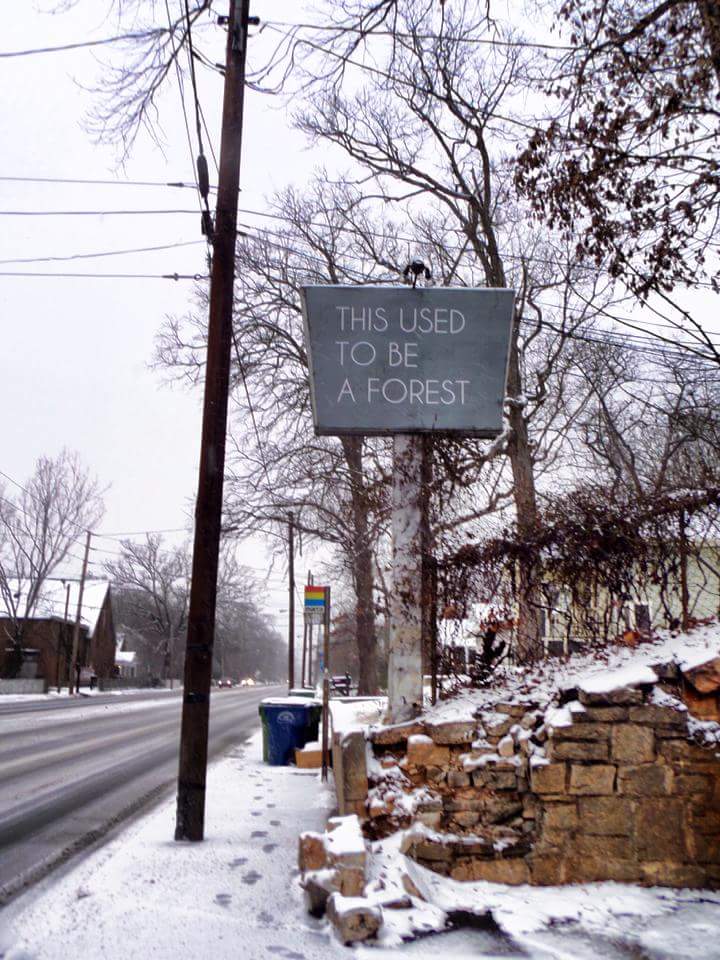
 2014 Moreland Avenue in East Atlanta (sign no longer there)
2014 Moreland Avenue in East Atlanta (sign no longer there)
